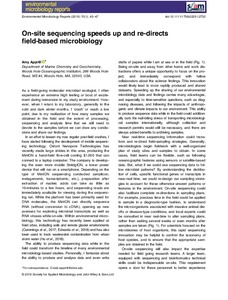On-site sequencing speeds up and re-directs field-based microbiology.
Abstract
As a field-going molecular microbial ecologist, I often
experience an extreme high feeling or bout of excitement
during immersion in my study environment. However,
when I return to my laboratory, generally in the
cold and dark winter months, I ‘crash’ or reach a low
point, due to my realization of how many samples we
obtained in the field and the extent of processing,
sequencing and analysis time that we still need to
devote to the samples before we can draw any conclusions
and share our findings.
In an effort to lessen my now regular post-field crashes, I
have started following the development of mobile sequencing
technology. Oxford Nanopore Technologies has
recently made large strides in this area, producing the
MinION a hand-held flow-cell costing $1,000 that can
connect to a laptop computer. The company is developing
the even more mobile SmidgION, a lower power
device that will run on a smartphone. Depending on the
type of MinION sequencing conducted (amplicon,
m.....
Journal
Environmental Microbiology ReportsVolume
11Page Range
pp.45-47Document Language
enSustainable Development Goals (SDG)
14Best Practice Type
Manual (incl. handbook, guide, cookbook etc)DOI Original
10.1111/1758-2229.12732Citation
Apprill, A. (2019) On‐site sequencing speeds up and re‐directs field‐based microbiology. Environmental Microbiology Reports, 11, pp.45-47. DOI: https://doi.org/10.1111/1758-2229.12732Collections
 Repository of community practices in Ocean Research, Applications and Data/Information Management
Repository of community practices in Ocean Research, Applications and Data/Information Management
